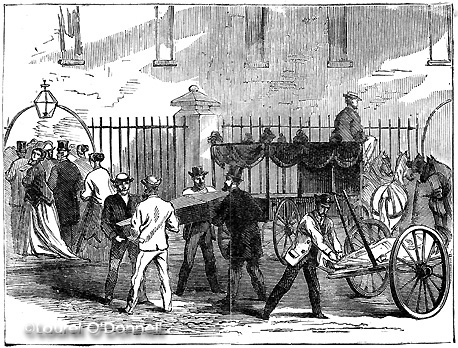|
div align="center"> |
Chapter V
Institutions of Manhattan Island and Westchester Co.
Bellevue Hospital,
page 2 of 2 The surgical instruments formerly kept here have been removed to the first floor, and placed with other curiosities in a large room adjoining the entrance hall. They are all placed in charge of one person, who is held responsible for their condition. The attic contains the tanks from which hot and cold water is distributed through the building. The Hospital has recently been furnished with spring beds, which, besides lessening the labor, adds greatly to the comfort of the patients. The museum is being steadily enriched with specimens of morbid anatomy, illustrating nearly every variety of disease. The Hospital is placed under a medical committee of inspection, who examine it weekly, making such recommendations as they think proper.
This Hospital, as all know, is a municipal institution, controlled by the Commissioners of Charities and Correction. Hence all sick poor are entitled to treatment free of charge. A surgeon is detailed to examine all applicants, and if they require continuous medical treatment he assigns them to their appropriate ward in the Hospital; if the illness is slight, they are sent to the Bureau of Out-door Sick. An average a seven or eight thousand are treated annually in this Hospital, about ten per cent. of whom die; a large part of the deaths occur, however, among infants and casualty patients. Though the patients are nearly all paupers, the surgeons employed are second to none, and the treatment throughout is the best science can afford. The bodies of the dead, unless taken away by their friends, are interred in the City Cemetery on Hart Island. As a school of clinical instruction; Bellevue ranks among the first in the world. The students of all medical schools in the city are granted admission tickets, and several hundred are in constant attendance. In 1866 the commissioners added the Medical and Surgical Bureau for the Relief of the Out-door Poor, which is manned by a large corps of physicians, who treated over 17,000 patients the last year. During the same year a building, similar to the famous Morgue of Paris, was constructed, as a temporary receptacle for the exhibition and identification of the unknown dead. The body is stretched upon a table so that it can be viewed through a glass, ceiling day and night for seventy-two hours. If not identified, a minute description of the person is recorded, a picture taken, and the garments worn are still kept on exhibition for twenty or more days. A convenient room has been added to this building for the deliberations of the coroners. During 1869 there were received at the Morgue 149 bodies, 70 of whom were recognized by friends, and 79 not identified. Several acres of ground are still connected with the Hospital. The yards are finely cultivated and add greatly to the beauty and healthfulness of the Institution.  Receiving and Removing Dead Bodies at the Morgue. |
|
197
:: Previous Page :: Next Page ::
:: Table of Contents :: :: New York State :: :: History Readings :: Books & articles appearing here are modified adaptations
from a private collection of vintage books & magazines. Reproduction of these pages is prohibited without written permission. © Laurel O’Donnell, 1996-2006.
|
|
